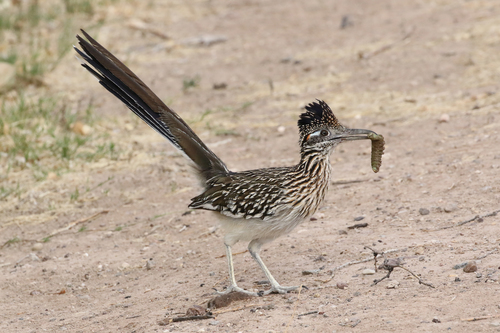
Greater Roadrunner
The Greater Roadrunner (*Geococcyx californianus*) is a charismatic and swift-running bird, iconic to the arid landscapes of the American Southwest and Mexico. This unique bird is primarily terrestrial, preferring to run rather than fly, and plays a significant ecological role as a predator of insects, reptiles, and small mammals. It is also deeply embedded in the folklore and culture of the region, often symbolizing speed, agility, and courage.
50-62 cm
Length
43-61 cm
Wingspan
Least Concern
Conservation Status
Distribution
Southwestern United States and Mexico. Ranges from California east to portions of Arkansas and Louisiana, and south into central Mexico. Generally non-migratory, though some populations may shift locally in response to food availability.
Lifespan
Typically 7-8 years in the wild.
Greater Roadrunner's Habitat
Habitat Types
Desert scrub, Arid grasslands, Chaparral, Open woodlands
Climate Zones
Arid, Semi-arid, Subtropical
Adaptations
Efficient kidneys to conserve water, nasal salt glands to excrete excess salt, and strong legs for running.
Variations
While generally consistent in appearance, slight variations in plumage coloration may occur across its range. No officially recognized subspecies are widely accepted.
Appearance
Breeding Plumage
Plumage is generally consistent year-round.
Seasonal Feather Changes
No significant seasonal variation.
Sex Based Plumage Differences
Males and females have very similar plumage.
Notable Features
Long tail used for balance and steering, Streaked brown and white plumage for camouflage, Zygodactyl feet (two toes forward, two toes backward), Bushy crest on the head
Diet and Feeding
Primary Foods
Insects, Lizards, Snakes (including rattlesnakes), Small rodents, Scorpions, Spiders, Small birds, Fruits, Seeds
Foraging Behavior
Primarily runs along the ground to chase prey. Will also occasionally leap into the air to catch insects or use its bill to probe under rocks and vegetation.
Specializations
Can subdue larger prey, such as snakes, by repeatedly pecking and slamming them against the ground.
Seasonal Diet Variations
Diet may shift slightly depending on prey availability, with more insects consumed during warmer months and more seeds and fruits during colder months.
Behavior
Social Structure
Generally solitary or found in pairs, except during breeding season.
Communication
Low, cooing vocalizations, Bill snapping, Tail movements (fanning and wagging)
Migration
Non-migratory, resident within its range.
Territorial or Group Behaviors
Pairs defend territories year-round, using vocalizations and chasing to deter intruders.
Conservation
Threats
Habitat loss due to urbanization and agriculture, Vehicle collisions, Pesticide exposure (through prey), Predation by domestic cats and dogs
Protection Programs
General wildlife protection laws, Habitat conservation efforts in some areas
Local National Laws
Protected under the Migratory Bird Treaty Act in the United States, although it is not a migratory bird.
Population Trend
Stable
Population Estimates
Difficult to estimate precisely, but considered relatively common within its range.
Interesting Facts
They can run at speeds up to 20 mph (32 km/h).
This speed allows them to catch fast-moving prey and escape predators.
They are known to kill and eat rattlesnakes.
They use their agility and sharp beaks to outmaneuver and subdue venomous snakes.
They are not strong fliers and prefer to run.
Their wings are relatively short and rounded, adapted for short bursts of flight rather than sustained soaring.
They can raise and lower their body temperature to conserve energy.
They can bask in the sun to warm up and seek shade to cool down, reducing their need for water.
Faqs about Greater Roadrunner
Are roadrunners related to ostriches?
No, roadrunners are members of the cuckoo family (Cuculidae), while ostriches belong to a completely different order (Struthioniformes).
Do roadrunners really say 'Meep meep'?
The 'Meep meep' sound is a fictionalized vocalization popularized by cartoons. Their actual calls are more like a series of dove-like coos.
Can roadrunners fly?
Yes, but they are not strong fliers and prefer to run. They typically only fly short distances to escape danger or reach a perch.
Are roadrunners dangerous to humans?
No, roadrunners are not aggressive towards humans and will typically avoid contact.
Copyright @ Nature Style Limited. All Rights Reserved.
 English
English